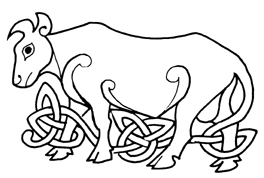Tuatha Dé Danann
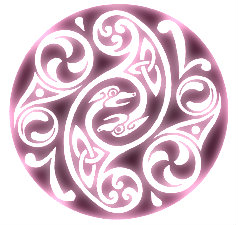 The Tuatha Dé Danann forms a significant feature in Irish, Scottish and Manx mythology. They are Celtic pre-Christian gods with supernatural ability and were of great importance to Gaelic people. They belong to the Otherworld (Aos Si) community whose world was reached through mists, hills, lakes, ponds, wetland areas, caves, ancient burial sites, cairns and mounds. Their association with ancient Neolithic and Bronze Age burial mounds is probably linked to the importance these sites had for the people of pre-history. They were places of communal interment for what many believe to be the ancestors of the Celts of northwest Europe. Their story was passed on for many centuries in oral tradition. Many of these legends were recorded in a collection of poems and texts, some dating from the third century AD, and compiled in the eleventh century by Christian scholars in such works as the Leabhar Gabhála Éireann known in English as The Book of Invasions.
The Tuatha Dé Danann forms a significant feature in Irish, Scottish and Manx mythology. They are Celtic pre-Christian gods with supernatural ability and were of great importance to Gaelic people. They belong to the Otherworld (Aos Si) community whose world was reached through mists, hills, lakes, ponds, wetland areas, caves, ancient burial sites, cairns and mounds. Their association with ancient Neolithic and Bronze Age burial mounds is probably linked to the importance these sites had for the people of pre-history. They were places of communal interment for what many believe to be the ancestors of the Celts of northwest Europe. Their story was passed on for many centuries in oral tradition. Many of these legends were recorded in a collection of poems and texts, some dating from the third century AD, and compiled in the eleventh century by Christian scholars in such works as the Leabhar Gabhála Éireann known in English as The Book of Invasions.
The name Tuatha Dé is thought to derive from old Irish Gaelic meaning ‘people of the gods’. The word ‘Danaan’ seems then to have been added later by Christian scribes. This was thought to be in order to differentiate the Tuatha Dé (people of the gods) known to the Gaels of Ireland, Scotland and the Isle of Man as part of their own pantheon, from the Israelites (people of god) highlighted in Christian teaching. The word Danaan is believed to come from old Gaelic literature; Dana being a Celtic female figure and goddess. The idea of waves of ‘invasions’ into Ireland was also probably further developed in an attempt by monastic scholars to create a history of Ireland that would also suggest some kind of link to one of the lost tribes of Israel.
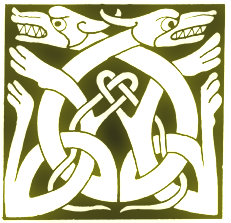
It was important over the period of Christian conversion in Ireland (from the fourth century AD onwards) for monastic scholars to ensure an easy transition from the people’s pre-Christian beliefs. In various ways these scribes attempted to explain away the old pagan gods. Whilst acknowledging that the Tuatha Dé Danann were worshipped as gods, some of the Christian scholars would simply state that the people were wrong to do so. Others would suggest they were fallen angels or just leave them as an historical part of an old belief. Another way to ease the transition from one belief system to another was to incorporate the old pagan deities into Christian belief. This could be said to be the fate of the Pagan Celtic Goddess Brigid. Brigid was written into Christian belief by the monastic scribes. This leaves Brigid keeping her place as Brigid the daughter of ‘The Dagda’ of the Tuatha Dé Danann. Thus she is celebrated in the pagan Gaelic festival of Imbolg on 1st February. Whilst being Saint Brigid in the Roman Catholic Church whose feast day falls on the same date.
‘The Dagda’ was a very important leader of the Tuatha Dé Danann. His brothers included Ogma and according to some sources Lir. Lir was known as the God of the Sea and is said to be the father of the children in the Irish legend of the 'Children of Lir'. He is also said to be the father of Manannán mac Lir, heavily associated with the Isle of Man where he is seen as the Islands first ruler. Manannán is also a significant feature in Scottish and Irish mythology. He is also cognate with the Welsh Manawydan fab Llŷr. Within these old beliefs other entities of the Otherworld are also mentioned. They include the Aos Si, sometimes suggested as separate from the Tuatha Dé Danann, and the Fomhóraigh. The Fomhóraigh have been seen by some as a darker more ominous relative. The distinctions between the Tuatha Dé Danann and the Fomhóraigh are however, blurred, with many interconnections and shared ancestry between the two. The idea of ‘fairies’ and the old burial mounds as ‘fairy hills’ seem to be a later anglicised invention/interpretation of the old stories.
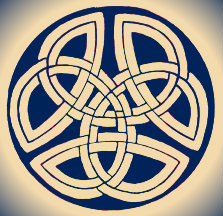 To conclude; the Tuatha Dé (Danann) formed an important part of the Gaelic peoples understanding of the world in which they lived. The myths and stories of these supernatural entities were handed down in oral tradition for centuries. Over time these stories varied and developed. The ancient tales were further altered and adapted by monastic scribes in order to adhere to their Christian belief whilst at the same time seeking to ease the people’s transition toward Christian conversion. In understanding this it needs to be acknowledged that the monastic scholars provided a valuable written account of elements of these ancient myths. They present some evidence to modern researchers who seek to unravel our ancestor’s beliefs and gain an understanding of the gods they worshipped. It also leads to the need for fair consideration being given as to why the population preferred to adapt themselves to the ‘new religion’. Inevitably because of the subject matter there are also those in recent history and now who prefer to take a very romantic and perhaps mystical view of the old beliefs giving them a ‘new age’ twist. Whether some prefer the adaption of the old stories that fit in with Christian beliefs, or the more modern mystical and romantic versions. The case remains that the Tuatha Dé was an important factor in Gaelic people’s pantheon. Therefore continued factual research and understanding of their place in Celtic history can only be valuable.
To conclude; the Tuatha Dé (Danann) formed an important part of the Gaelic peoples understanding of the world in which they lived. The myths and stories of these supernatural entities were handed down in oral tradition for centuries. Over time these stories varied and developed. The ancient tales were further altered and adapted by monastic scribes in order to adhere to their Christian belief whilst at the same time seeking to ease the people’s transition toward Christian conversion. In understanding this it needs to be acknowledged that the monastic scholars provided a valuable written account of elements of these ancient myths. They present some evidence to modern researchers who seek to unravel our ancestor’s beliefs and gain an understanding of the gods they worshipped. It also leads to the need for fair consideration being given as to why the population preferred to adapt themselves to the ‘new religion’. Inevitably because of the subject matter there are also those in recent history and now who prefer to take a very romantic and perhaps mystical view of the old beliefs giving them a ‘new age’ twist. Whether some prefer the adaption of the old stories that fit in with Christian beliefs, or the more modern mystical and romantic versions. The case remains that the Tuatha Dé was an important factor in Gaelic people’s pantheon. Therefore continued factual research and understanding of their place in Celtic history can only be valuable.
Many of the Tuatha Dé Danann are mentioned in the Book of Leinster, compiled in the mid twelfth century but comprising of older texts, themselves based on age-old oral tradition.
Below are just some of the important figures which have been linked by various sources to the Tuatha Dé Danann. Their inter-connections and attributes can vary in different texts and the brief descriptions given underneath are by no means definitive:
Dagda (The Dagda)
- The leader and father figure and druid of the Tuatha Dé and symbol of life and death. Also known as Ruadh Rofhessa (Red One Great in Knowledge).
- He is said to have had a bottomless cauldron and to have been very powerful, wielding a mighty club. Dagda was seen to be a wise leader with abundant skills and is known as ‘the good god’.
- Amongst his many lovers he is noted for his relationship with Boann, a river goddess from whom the River Boyne takes its name. Among Dagda’s offspring is Brigid and he is a brother of Ogma.
Lir
- God of the Sea.
- Father of Manannán mac Lir. Also seen as the father of the Children of Lir renowned in Irish Legend.
- He is cognate with the Welsh God Llŷr.
- Both Lir and Manannán are mentioned in the work ‘Sanas Cormaic’ by Cormac mac Cuilennáin, King of Munster. In his 9th century glossary he links both to the sea.
Ogma
- Brother of The Dagda, associated with learning and credited with creating Ogham script.
- A noted warrior he was killed in battle.
Lugh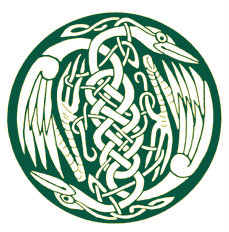
- God of the sun and light, harvests and associated with arts and crafts.
- A great warrior and according to the Ulster Cycle father of the legendary Cú Chulainn.
- Linked to a number of sites in Ireland he spent part of his childhood in the Isle of Man where he was trained by Manannán mac Lir who loaned him his horse Enbarr who could travel over land and sea.
Nuada (of the Silver Arm)
- Once King of the Danaans.
- His hand lost in battle it was replaced with one made of silver.
- Lugh was said to have fought on behalf of the Tuatha Dé Danann whilst Nuada was having his new silver arm made.
Dian Cécht
- Grandfather of Lugh.
- He is the god of medicine and made the arm of silver for Nuada.
Brigid
- Daughter of The Dagda.
- Goddess and also origin of the Christian Saint Brigid. She was a fertility goddess and is associated with the feast of Imbolg. Imbolg is the second of the four ancient yearly Celtic festivals.
-
The four yearly Celtic festivals are:
- Sumhain - start of the winter and New Year celebrated on the eve of 31st October and the origin of Halloween.
- Imbolg - start of spring on 1st February.
- Bealtaine - start of summer on 1st May.
- Lúnasa - start of autumn and associated with harvests on the first of august.
Dana
- Described by some as an Irish mother goddess and the mother of the Danaans.
Aengus Óg
- Son of Dagda and Boann and associated with love.
- He is said to have taken possession of Brú na Bóinne (Boyne Valley), which is the location of the ancient monuments of Newgrange, Knowth and Dowth.
Morrigan
- Irish Goddess associated with war, prophesy and the ability to enchant.
- In the Ulster Cycle she is depicted changing her form into a wolf, eel and cow in her entanglement with Cú Chulainn. Sometimes described as forming one of three sister goddesses.
Áine
- Associated with sovereignty and a number of sites around Ireland bare her name. She is seen as linked to summer and the sun and therefore also to good harvests.
Macha
- One of a number of figures named Macha in Celtic mythology.
-
Macha wife of Cruinniac is associated with the curse of the warriors of Ulster. Cruinniuc boasted that his wife could run faster than the king’s horses; the king then ordered she race against them. Macha was forced to do this even though in the later stages of pregnancy. Although she won the race she gave birth to twins directly afterwards and she cursed the men of Ulster for the ordeal she had been put through. The nature of the curse was that at the time they were needed the most they were laid low.
In the story of the Táin Bó Cúailnge contained within the stories of the Ulster Cycle, Macha’s curse delays the warriors of Ulster from coming to the aid of Cú Chulainn. He is left alone to fight off the forces of Queen Medb of Connaught until the Ulster warriors recover from the curse. Stories contained in the Ulster Cycle are thought to date from before 400AD.
Sionna
- Granddaughter of Lir - associated with Spring water.
- She goes to Cóelrind Well to gain knowledge but is drowned when not adhering to established protocols. She is swept along the waters of the flooding well which form the River Shannon which is named after Sionna.
Manannán mac Lir
- Son of Lir and associated with islands, magical mists and the sea.
- Said to be first ruler of the Isle of Man, he fostered and trained Lugh there before being sent back to Ireland to engage in battle. Manannán's wife was Fand who sought to lure Cú Chulainn from Emer. This story is recounted in the tale Serglige Con Culainn from the Ulster Cycle.
Tre Dee' Dana
-
The three brothers of Art and Craftsmanship:
- Gobniu - the smith.
- Credne - the goldsmith.
- Luchtaine - the carpenter. They forged the weapons that the Tuatha Dé Danann used in battle.
Recommended further reading
Early Irish Myths and Sagas by Jeffrey Gantz is a fasincating compilation of early Irish stories first written down in the 8th century. Get your copy from Amazon.com (US$) and Amazon.co.uk (GB£):
The images on this page have been created using designs taken from Celtic Design by Dover Publications. Get your copy from Amazon.com (US$) and Amazon.co.uk (GB£):
Other articles of interest
- Celtic Majesty of Brigid – The Feast of Imbolg
- Legend of the 'Children of Lir'
- The Ulster Cycle (an Rúraíocht)
- Fand, Queen of the Fairies
Content type:
- Pan-Celtic
Language:
- English



